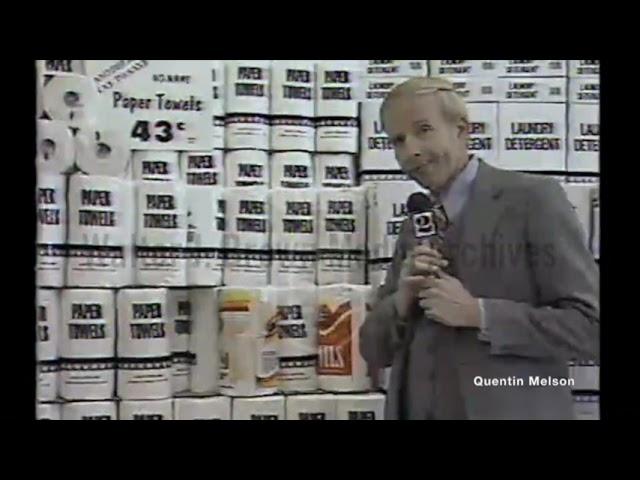
The Introduction of Generic Brands to Grocery Stores (April 16, 1980)
Various shots of people shopping in Big Star supermarket. Shots of goods for sale. Reporter McClellan narrates, explaining that the store has introduced “no name brand” products, and that consumers are buying them. An unidentified woman is interviewed about the new, cheaper products. Another unidentified woman is interviewed about them as well.
Reporter: McClellan, Don
Generic brands are often associated with store brands. Generic products were first introduced in the United States in 1977,[38][39][40] quickly winning market share from national and private-label brands.[41] A 1981 academic article described them as products "without brand names, in very plain packages with simple labels and usually sold at prices below both the national and private brands with which they compete".[38] Packages of generic products often feature only the name of the type of product it contains, e.g. "Cola" or "Batteries".[39] Nowadays, the terms generic brand and store brand are sometimes used interchangeably.[14][42][43] The term generic can be used as a pejorative toward store brand items that are perceived as bland or cheap.[44][45]
A private-label brand is often produced by the same company that manufactures the national brand of that product.[46] Different brands target different consumers. For instance, Kimberly-Clark makes Huggies diapers, but also produces a Walmart budget version.[47] Allegedly, some store-brand items are identical to their name-brand counterparts: they are said to be literally the same product, except for the packaging and price.[42] In other cases, a manufacturer can have multiple formulas for one product, creating a private-label version using one method and the national-label version using another.[48] In 2007, a mass-recall of contaminated pet food products brought to light that more than 100 different brands of pet food, both premium- and private-label, were in fact produced by a single company: Menu Foods Inc. in Ontario, Canada. The ingredients and recipes they used differed substantially among brands, depending on what their clients specified.[47]
Generic brands of consumer products (often supermarket goods) are distinguished by the absence of a brand name, instead identified solely by product characteristics and identified by plain, usually black-and-white packaging. Generally they imitate more expensive branded products, competing on price. They are similar to "store brand" or "private label" products sold under a brand particular to the merchant, but typically priced lower and perceived as lower quality. The term of brand is sometimes used. In the United Kingdom, these products are often referred to as "own brand" items.
Characteristics
Generics may be manufactured by less prominent companies or manufactured on the same production line as branded products. Generic brand products may be of similar quality as a branded product, and are commonly made from the standard ingredients used for branded products.
Without the costs of marketing individual products, generic brands are priced lower than branded products.[1] They are preferred by customers for whom price or value-for-money is the priority.[2] They are generally more popular in recessionary times, when consumers' purchasing power is lower, putting them on the lookout for value-for-money products; they experienced a period of popularity in the United States in the late 1970s and early 1980s,[3] during a period of high price inflation.
Consumer perceptions about generic brands differ widely. A generic brand skin care product may have a consumer unsure about its ‘health and safety’ quotient. This implies that there are certain product categories more aligned to generic brands. Examples include over-the-counter medications, cereal and gasoline among others.
The German discount supermarket Aldi is known for their own brand goods and absence of branded goods with minor exceptions.
There has been a growth in demand for generic brand goods since the late-2000s, and the stigma of the absence of a brand name is declining with time; as food inflation reaches new highs in 2022, and sales of branded food products decline. [4]
Reporter: McClellan, Don
Generic brands are often associated with store brands. Generic products were first introduced in the United States in 1977,[38][39][40] quickly winning market share from national and private-label brands.[41] A 1981 academic article described them as products "without brand names, in very plain packages with simple labels and usually sold at prices below both the national and private brands with which they compete".[38] Packages of generic products often feature only the name of the type of product it contains, e.g. "Cola" or "Batteries".[39] Nowadays, the terms generic brand and store brand are sometimes used interchangeably.[14][42][43] The term generic can be used as a pejorative toward store brand items that are perceived as bland or cheap.[44][45]
A private-label brand is often produced by the same company that manufactures the national brand of that product.[46] Different brands target different consumers. For instance, Kimberly-Clark makes Huggies diapers, but also produces a Walmart budget version.[47] Allegedly, some store-brand items are identical to their name-brand counterparts: they are said to be literally the same product, except for the packaging and price.[42] In other cases, a manufacturer can have multiple formulas for one product, creating a private-label version using one method and the national-label version using another.[48] In 2007, a mass-recall of contaminated pet food products brought to light that more than 100 different brands of pet food, both premium- and private-label, were in fact produced by a single company: Menu Foods Inc. in Ontario, Canada. The ingredients and recipes they used differed substantially among brands, depending on what their clients specified.[47]
Generic brands of consumer products (often supermarket goods) are distinguished by the absence of a brand name, instead identified solely by product characteristics and identified by plain, usually black-and-white packaging. Generally they imitate more expensive branded products, competing on price. They are similar to "store brand" or "private label" products sold under a brand particular to the merchant, but typically priced lower and perceived as lower quality. The term of brand is sometimes used. In the United Kingdom, these products are often referred to as "own brand" items.
Characteristics
Generics may be manufactured by less prominent companies or manufactured on the same production line as branded products. Generic brand products may be of similar quality as a branded product, and are commonly made from the standard ingredients used for branded products.
Without the costs of marketing individual products, generic brands are priced lower than branded products.[1] They are preferred by customers for whom price or value-for-money is the priority.[2] They are generally more popular in recessionary times, when consumers' purchasing power is lower, putting them on the lookout for value-for-money products; they experienced a period of popularity in the United States in the late 1970s and early 1980s,[3] during a period of high price inflation.
Consumer perceptions about generic brands differ widely. A generic brand skin care product may have a consumer unsure about its ‘health and safety’ quotient. This implies that there are certain product categories more aligned to generic brands. Examples include over-the-counter medications, cereal and gasoline among others.
The German discount supermarket Aldi is known for their own brand goods and absence of branded goods with minor exceptions.
There has been a growth in demand for generic brand goods since the late-2000s, and the stigma of the absence of a brand name is declining with time; as food inflation reaches new highs in 2022, and sales of branded food products decline. [4]
Комментарии:
The Introduction of Generic Brands to Grocery Stores (April 16, 1980)
Foggy Melson's Breakdown
tyler1's loudest scream but...
ChromaticÆ+
Madonna - Gambler (1985 - HD Artificial Intelligence Remaster)
Un Tiempo Para Recordar HD
Thunderdome 2022 | DRS
Thunderdome
Rutgers is Meeting the Demand for Nurses
Rutgers University
Improve Stability: 7 Simple Balance Workouts for Seniors (2024)
Ageless Health Club
It's Getting Worse For MrBeast...
SomeOrdinaryGamers


























